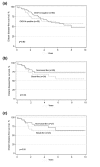Basal-like phenotype is not associated with patient survival in estrogen-receptor-negative breast cancers
- PMID: 17263897
- PMCID: PMC1851391
- DOI: 10.1186/bcr1649
Basal-like phenotype is not associated with patient survival in estrogen-receptor-negative breast cancers
Abstract
Introduction: Basal-phenotype or basal-like breast cancers are characterized by basal epithelium cytokeratin (CK5/14/17) expression, negative estrogen receptor (ER) status and distinct gene expression signature. We studied the clinical and biological features of the basal-phenotype tumors determined by immunohistochemistry (IHC) and cDNA microarrays especially within the ER-negative subgroup.
Methods: IHC was used to evaluate the CK5/14 status of 445 stage II breast cancers. The gene expression signature of the CK5/14 immunopositive tumors was investigated within a subset (100) of the breast tumors (including 50 ER-negative tumors) with a cDNA microarray. Survival for basal-phenotype tumors as determined by CK5/14 IHC and gene expression signature was assessed.
Results: From the 375 analyzable tumor specimens, 48 (13%) were immunohistochemically positive for CK5/14. We found adverse distant disease-free survival for the CK5/14-positive tumors during the first years (3 years hazard ratio (HR) 2.23, 95% confidence interval (CI) 1.17 to 4.24, p = 0.01; 5 years HR 1.80, 95% CI 1.02 to 3.15, p = 0.04) but the significance was lost at the end of the follow-up period (10 years HR 1.43, 95% CI 0.84 to 2.43, p = 0.19). Gene expression profiles of immunohistochemically determined CK5/14-positive tumors within the ER-negative tumor group implicated 1,713 differently expressed genes (p < 0.05). Hierarchical clustering analysis with the top 500 of these genes formed one basal-like and a non-basal-like cluster also within the ER-negative tumor entity. A highly concordant classification could be constructed with a published gene set (Sorlie's intrinsic gene set, concordance 90%). Both gene sets identified a basal-like cluster that included most of the CK5/14-positive tumors, but also immunohistochemically CK5/14-negative tumors. Within the ER-negative tumor entity there was no survival difference between the non-basal and basal-like tumors as identified by immunohistochemical or gene-expression-based classification.
Conclusion: Basal cytokeratin-positive tumors have a biologically distinct gene expression signature from other ER-negative tumors. Even if basal cytokeratin expression predicts early relapse among non-selected tumors, the clinical outcome of basal tumors is similar to non-basal ER-negative tumors. Immunohistochemically basal cytokeratin-positive tumors almost always belong to the basal-like gene expression profile, but this cluster also includes few basal cytokeratin-negative tumors.
Figures




References
-
- Gruvberger S, Ringnér M, Chen Y, Panavally S, Saal LH, Borg Å, Fernö M, Peterson C, Meltzer PS. Estrogen receptor status in breast cancer is associated with remarkably distinct gene expression pattern. Cancer Res. 2001;61:5979–5984. - PubMed
-
- Pusztai L, Ayers M, Stec J, Clark E, Hess K, Stivers D, Damokosh A, Sneige N, Buchholz TA, Esteva FJ, et al. Gene expression profiles obtained from fine-needle aspiration of breast cancer reliably identify routine prognostic markers and reveal large-scale molecular differences between estrogen-negative and estrogen-positive tumors. Clin Cancer Res. 2003;9:2406–2415. - PubMed
Publication types
MeSH terms
Substances
LinkOut - more resources
Full Text Sources
Medical
Molecular Biology Databases
Research Materials

